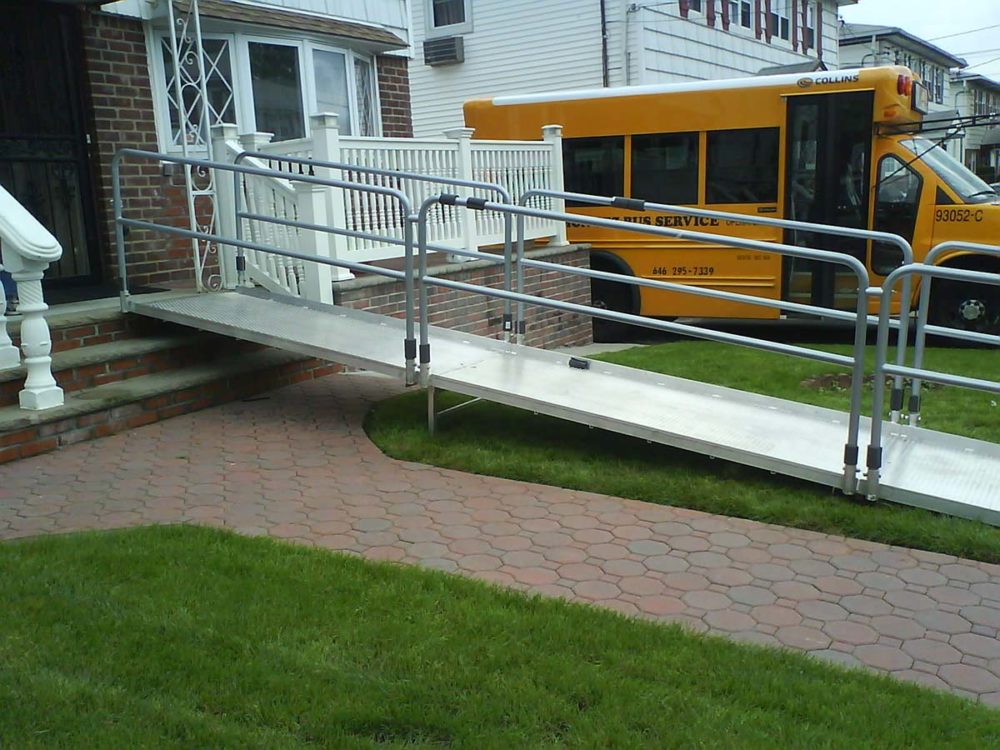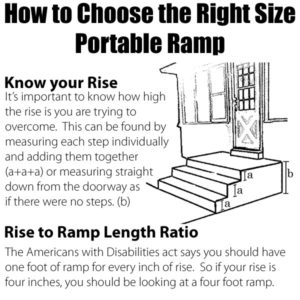“What length ramp should I order for X stairs?”
It’s the question that should be asked when you first look into purchasing a wheelchair ramp. It gets you thinking about how steep that slope will be and how to make it as easy as possible on yourself or your loved ones. Placement rise directly affects how long a ramp you need.
Here’s how Thom, our CEO, responded;
“This is not a simple answer. Here are some factors that should be considered: Stairs typically run about 7.5 inches high each so for three stairs a standard rise or height would be about 22 inches. The ADA [Americans with Disabilities Act] recommends 1 foot for ramp for every one inch of rise. Assuming your stairs are a standard height this means you should buy 22 feet of ramp using the Government standard. That’s a very long ramp and for most residential situations, prohibitive in terms of size and often cost. In a home setting, a shorter ramp using a one foot of ramp for every 2 inches of rise will often suffice both in terms of safety and effectiveness. (That would translate into a 12 foot portable ramp.)
Other factors that should be considered include: The weight of the wheelchair and the person in it, the strength of the person assisting if it is a manual chair or the power of the wheelchair if it is a power-chair. To help you make the right decision I would suggest talking with an expert to help you understand all of your options. You can call Handi-Ramp and they can help you decide what is right for your circumstances. I’m guessing other vendors have people to talk with as well, but I only know what it is that we offer.”
Estimating by stairs can be tricky but knowing your rise is a key part to ramp safety. Measuring each step and adding them together is one way to get a more accurate rise. Or if you are able to measure straight down from the landing level as if there are no stairs.
Modular, Semi-Permanent Ramp Installations for 3 Steps
For a Semi-permanent or occasionally deployable ramp installation, we recommend purchasing a modular, aluminum ramp system for safe, affordable wheelchair access. Folding portable ramps are excellent tools when you’re traveling and anticipate the need to bridge a step or two. For example, perhaps you’re visiting a family member’s home with one step to the front porch. A folding ramp can be lifted into an SUV and installed in seconds to allow a loved one in a wheelchair to easily enter the home.

On the other hand, if you need a ramp for a set of three or more stairs, a modular ramp is the safest, longest-lasting solution. Modular ramps have several advantages in these situations. First, they come in longer lengths (12 feet or more) making them much safer for a three step rise. Second, their interlocking construction and adjustable support legs provide more stability than a folding ramp. Finally, you can add handrails to most modular ramps, adding a necessary layer of safety and security for someone in a walker or when the weather creates slip-and-fall conditions for everyone using the ramp . . . including the mailman!
While technically portable, modular ramps do take time to assemble and disassemble. Some modular wheelchair ramps, like ours, can be assembled by two people without hand tools in under thirty minutes. Other modular ramps require wrenches or ratchets to tighten bolts and to cinch up sections.
Needless to say, we favor our own Handi-Ramp Modular Portable Wheelchair Ramps. Available in lengths from 12 to 18 feet, the ramps come in interlocking sections each weighing under 35 pounds. Included are support legs that provide excellent stability and confidence that’s simply missing from portable folding ramps. While the initial investment might be a bit more, the Handi-Ramp modular wheelchair ramps come with a 20 year warranty. Our ramps also feature heavy duty aluminum Handi-Treads flooring with our patented, 360-degree traction buttons. Unlike most portable ramps that rely on grit tape for traction, Handi-Ramp modular ramps provide excellent traction in rain, ice or snow and can be cleared with a snow shovel when necessary.
Portable Folding Ramp Recommendations for 3 Steps
If the sum of the rise (height) of the three steps is 20 inches or less, then we have three folding ramp recommendations. First, our Handi-Ramp portable, folding wheelchair ramp comes in 10-foot and 12-foot lengths – the longest portable folding ramps on the market. To provide safety and strength, longer folding ramps can be quite heavy. For example, our 10 foot ramp weighs 82 pounds and the 12 foot ramp weighs nearly 100 pounds. The price of quality is weight, and there’s no stronger portable folding ramp on the market than these.
A second choice is the EZ access Suitcase Trifold Ramp which comes in a 10 foot length that weighs in at over 80 lbs. A ten foot ramp is minimally suitable for most situations where you’ve got 3 steps to overcome and the rise is 20″ or less. Assistance would be needed for a person in a wheelchair to insure their safety.
A third choice is the EZ Access Suitcase® Singlefold Ramps. This ramp is available in an 8-foot length, which is the minimum length we might recommend for three short steps with a combined rise of 16 inches or less which is slightly higher than two standard steps. The recommendation of 8 feet assumes that the person in the wheelchair will always be attended by a helper. If a person in a wheelchair is to navigate the ramp on their own, a longer ramp will be required.)

We here at Handi-Ramp talk all day about rises and ramp lengths. Give us a call at 800-876-7267, and speak with one of our experts today.
Thom Disch
Award-winning author Thom Disch is owner and CEO of Handi Products that sells a variety of accessibility, commercial, and home products creating a safer environment for their customers. Thom is a leading expert and speaker on slip, trip, and fall injuries in the United States and has been compiling statistics and stories related to this healthcare crisis for ten years. Thom is also a serial entrepreneur and owns several companies and nationally known brands, including Handi-Ramp (handiramp.com), PetSTEP International (Petstep.com), and Industrial Toolz, Inc. (Industrialtoolz.com).



